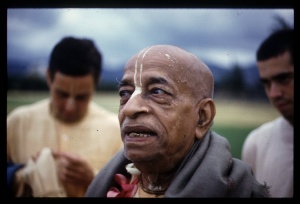CC Adi 7.33 (1975)

A.C. Bhaktivedanta Swami Prabhupada
Below is the 1996 edition text, ready to be substituted with the 1975 one using the compile form.
TEXT 33
- eta bali’ mane kichu kariyā vicāra
- sannyāsa-āśrama prabhu kailā aṅgīkāra
SYNONYMS
eta bali’—saying this; mane—within the mind; kichu—something; kariyā—doing; vicāra—consideration; sannyāsa-āśrama—the renounced order of life; prabhu—the Lord; kailā—did; aṅgīkāra—accept.
TRANSLATION
Thus the Lord accepted the sannyāsa order of life after full consideration.
PURPORT
There was no need for Lord Śrī Caitanya Mahāprabhu to accept sannyāsa, for He is God Himself and therefore has nothing to do with the material bodily concept of life. Śrī Caitanya Mahāprabhu did not identify Himself with any of the eight varṇas and āśramas, namely, brāhmaṇa, kṣatriya, vaiśya, śūdra, brahmacārī, gṛhastha, vānaprastha and sannyāsa. He identified Himself as the Supreme Spirit. Śrī Caitanya Mahāprabhu, or for that matter any pure devotee, never identifies with these social and spiritual divisions of life, for a devotee is always transcendental to these different gradations of society. Nevertheless, Lord Caitanya decided to accept sannyāsa on the grounds that when He became a sannyāsī everyone would show Him respect and in that way be favored. Although there was actually no need for Him to accept sannyāsa, He did so for the benefit of those who might think Him an ordinary human being. The main purpose of His accepting sannyāsa was to deliver the Māyāvādī sannyāsīs. This will be evident later in this chapter.
Śrīla Bhaktisiddhānta Sarasvatī Ṭhākura has explained the term “Māyāvādī” as follows: “The Supreme Personality of Godhead is transcendental to the material conception of life. A Māyāvādī is one who considers the body of the Supreme Personality of Godhead Kṛṣṇa to be made of māyā and who also considers the abode of the Lord and the process of approaching Him, devotional service, to be māyā. The Māyāvādī considers all the paraphernalia of devotional service to be māyā.” Māyā refers to material existence, which is characterized by the reactions of fruitive activities. Māyāvādīs consider devotional service to be among such fruitive activities. According to them, when bhāgavatas (devotees) are purified by philosophical speculation, they will come to the real point of liberation. Those who speculate in this way regarding devotional service are called kutārkikas (false logicians), and those who consider devotional service to be fruitive activity are called karma-niṣṭhas. Those who criticize devotional service are called nindakas (blasphemers). Similarly, nondevotees who consider devotional activities to be material are called pāṣaṇḍīs, and scholars with a similar viewpoint are called adhama paḍuyās.
The kutārkikas, nindakas, pāṣaṇḍīs and adhama paḍuyās all avoided the benefit of Śrī Caitanya Mahāprabhu’s movement of developing love of Godhead. Śrī Caitanya Mahāprabhu felt compassion for them, and it is for this reason that He decided to accept the sannyāsa order, for by seeing Him as a sannyāsī they would offer Him respects. The sannyāsa order is still respected in India. Indeed, the very dress of a sannyāsī still commands respect from the Indian public. Therefore Śrī Caitanya Mahāprabhu accepted sannyāsa to facilitate preaching His devotional cult, although otherwise He had no need to accept the fourth order of spiritual life.